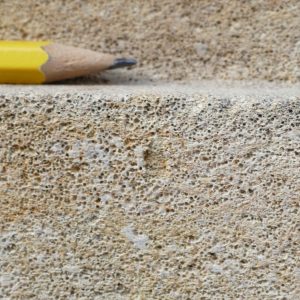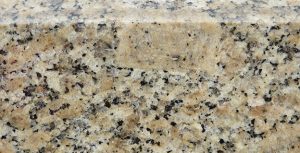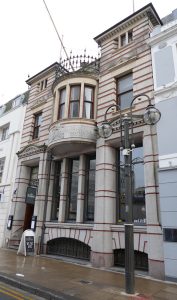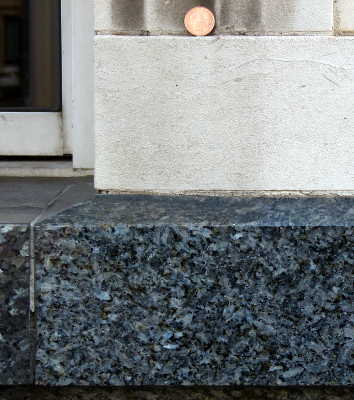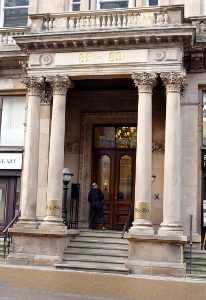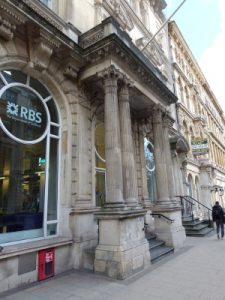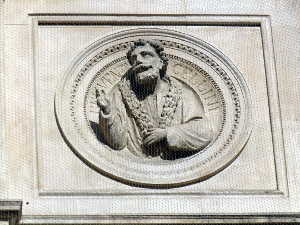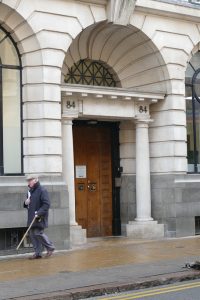Birmingham Building Stones Trails
Trail 1: From the Town Hall to the Cathedral continued
On the opposite side of the road is Starbucks, and 125 Colmore Row.
A large, post-modern style office block, also housing Starbucks Coffee shop, is situated at 125 Colmore Row. The main structure is clad in a yellow-coloured synthetic stone but the foundations are clad in a garnet-bearing metagranite called Giallo Cecilia. This is one of several decorative stones quarried from a suite of igneous rocks in the state of Espirito Santo, a state on the eastern seaboard of Brazil. Five suites of granite emplacement have been recognised in this terrane, known as the Carlos Chagas Suite, with the older phases of activity having become progressively deformed; Giallo Cecilia is from the second intrusive suite. They were intruded between 630-480Ma during the Neoproterozoic-Cambrian Aracuai Orogeny. Granites quarried from these plutons have been subjected to tropical chemical weathering in their upper portions which has stained them with goethite, hence their trade names having the prefix ‘giallo’ (Italian for yellow). The rock is composed of orthoclase, quartz, plagioclase, biotite and garnet and shows a strong foliation, with even some of the garnet porphyroblasts having been sheared through. The garnets are large and red, up to 1 cm in diameter.
10. 115 Colmore Row
Next door is 115 Colmore Row also built in a post-modern style with a yellow granite used for the foundations. This is Giallo Dorata (also known as Golden Carioca), another ‘giallo’ granite from the Carlos Chagas Suite of Espirito Santo in Brazil (see 125 Colmore Row above). This stone is from the latest suite of intrusions in this region, emplaced in the early Cambrian. The stone is extracted from the Medina-Pedro Azul Pluton, which is also worked for its gem quality topaz-aquamarine pegmatites. This stone contains orthoclase, plagioclase, quartz and biotite. Orthoclase is also present in euhedral, zoned megacrysts, several centimetres in length. Though superficially similar in appearance to the synthetic cladding of 125 Colmore Row, number 115 is clad with Bath Stone. Like Portland Stone, Bath Stone is an oolitic limestone, the ooids often weathering in on the surface, however although it is Jurassic in age it is older than the Portland limestones. This variety, also containing small, fossil echinoids (sea urchins) is Oxfordian in age (mid-late Jurassic, c.160Ma) and is specifically a variety of Bath Stone called Coombe Down Stone. The sections through echinoids resemble slices through mushrooms. Distinctively, it contains fine, discontinuous, calcite-cemented ‘stringers’ known as ‘watermarks’ which are particularly obvious in this example.
11. 110 Colmore Row
This building was erected for the Scottish Union and National Insurance Company by architects Henman & Cooper in 1904. Fittingly the main stones featuring here are Scottish granites. The pink granite on the foundations is Devonian Peterhead Granite from Stirlinghill on the coast north of Aberdeen. This stone will be further described when it is more easily observed in the Cathedral yard (below). Above this, the first storey is clad in a pale-grey, two-mica granite. This may well be Dalbeattie Granite, which derives from the Early Devonian Criffel-Dalbeattie pluton (c.400Ma) in the Southern Uplands.
12. 98 Colmore Row
98 Colmore Row stands on the corner of Colmore Row and Bennetts Hill. The main building stone is a rather grubby Portland Whitbed. However the foundations and door-surround are clad in larvikite, Norway’s National Stone. This is the variety of this stone marketed as Marina Pearl Larvikite and it is composed of perthitic feldspars (a mixture of plagioclase and orthoclase) which have a pearlescent shimmer. This optical phenomenon is known as schillerescence in feldspars and the varieties of larvikite show it off to a good effect. Also present is the feldspathoid mineral nepheline and dark-coloured (mafic) minerals are biotite, magnetite and the pyroxene variety titanaugite. The stone is sourced from a large, multiple intrusion near the town of Larvik in the Vestfold region on the south coast of Norway. These plutonic rocks were emplaced during Permian extension in the Oslo Graben at 290Ma. They have been quarried commercially since the 1880s and have become hugely popular worldwide ever since as an ornamental stone for interior design and as exterior cladding.
On the opposite side of the road is 85-89 Colmore Row.
13. 85-89 Colmore Row
This grand-looking building stands on the corner of Newhall Street and Colmore Row, built in the ‘Florentine Renaissance’ style; this is another building designed by Yeoville Thomason (of Council House fame) dating from 1869 and modified in 1885. This is built from a buff-yellow to pale brown, cross-bedded sandstone, which is probably Coxbench or Darley Dale Sandstone or a similar Upper Carboniferous sandstone, as used at the Museum & art Gallery, the Council House and around Victoria Square.
Continue along the north side of Colmore Row.
This building, also appearing generically yellow in sunlight, is clad in Bath Stone. However, look carefully as some areas have been patched with a yellowish concrete, rich in a sharp quartz sand aggregate. This can be mistaken for a sandstone. The true Bath Stone is an oolitic limestone and the spherical ooids can be seen on the surface, weathering in as ovoid or circular, tiny, pits. These are just visible to the naked eye and are easily seen with a hand lens. Finely comminuted shell fragments are also present. The yellow colour, imparted by traces of the iron oxide hydroxide mineral goethite and the way the ooids weather in as pits, distinguishes Bath Stone from Portland Stone. Nevertheless both are Jurassic oolites formed in the subtropical seas that dominated western Europe during the Jurassic. Bath Stone is quarried from underground workings from the Middle Jurassic (Oxfordian) Chalfield Oolite Formation (c.160Ma).
This is a very decorative building with roundels depicting the Italian Renaissance goldsmiths Cellini and Ghiberti (the original owner, William Spurrier, sold silver and gold plate), vases and swags of flowers, Corinthian columns and capitals and rusticated stonework. It was designed by J. A. Chatwin and completed in 1873.
15. 84 Colmore Row
Across the road, 84 Colmore Row again is built with a grubby Portland Stone on its rusticated and moulded upper storeys. The heavy foundation courses are of a grey, foliated granite. This is one of the Ordovician Scottish Grampian granites and is almost certainly Rubislaw Granite quarried from the 470Ma Aberdeen Pluton. Rubislaw Quarry lies on the western side of Aberdeen, and at 142m deep is one of the largest man-made holes in Europe. It closed in 1971 after 200 years of production.
Walk 1 continues on the next page…
References can be found on the last page of the walk (1.4).


